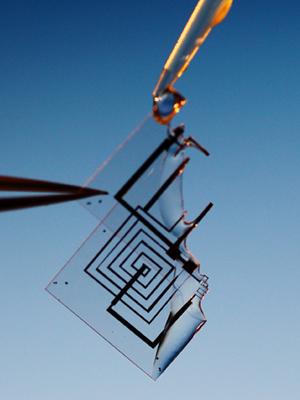Disappearing Act: Biocompatible Electronics Vanish When No Longer Needed
Electronics Could Have Applications in Medicine, Pharmaceuticals, Military, and More
An interdisciplinary team of researchers from Northwestern University, the University of Illinois at Urbana-Champaign and Tufts University are the first to demonstrate “transient electronics” -- which are electronics that gradually disappear on a specified schedule, whether it be a few days or six months.
These kinds of electronics could have applications in medicine, pharmaceuticals, environmental monitors and the military, among other uses.
Conventional electronics are made to last indefinitely. Transient electronics, on the other hand, offer the opposite behavior. They physically vanish over time in a well-controlled manner and at a prescribed time, dissolving when they react with water. A magnesium oxide encapsulation layer and silk overcoat envelops the electronics, and the thickness determines how long the system will take to disappear into its environment.
“These electronics are there when you need them, and after they’ve served their purpose they disappear,” said Yonggang Huang, who led the Northwestern portion of the research focused on theory, design and modeling. “This is a completely new concept.”
The novel technology opens up important possibilities. Transient electronics could be useful as medical devices implanted inside the human body to monitor such things as temperature or brain, heart and muscle tissue activity, to apply thermal therapy or to deliver drugs. When no longer needed, the electronics would be fully absorbed by the body with no adverse effects. (Implantable electronics are not commonly used in medicine because of concern about the long-term effects.)

Such a system also could be used as environmental monitors placed on buildings, roadways or military equipment to detect temperature change or structural deformation. The device would dissolve when exposed to water, eliminating the need for it to be recovered at a future date.
Details of the biocompatible electronics will be published in the Sept. 28 issue of the journal Science.
“We selected materials familiar to the human body, such as magnesium,” said Huang, a senior author of the paper and the Joseph Cummings Professor of Civil and Environmental Engineering and Mechanical Engineering at Northwestern’s McCormick School of Engineering and Applied Science. “We didn’t want to use a material the body has no experience with.”
While the researchers studied a number of different biocompatible materials, including zinc and iron, they focused on silicon-based electronics with conductors made of magnesium. The key question they needed to answer was: How long will it take the entire electronic device to dissolve?
The device is made up of the electronics and encapsulation layers (a magnesium oxide layer covered by a silk overcoat) surrounding the electronics. The encapsulation layers are the first to dissolve and dictate the first dissolution timescale. The magnesium electrodes in the electronics define the second timescale. These combined lengths of time determine the dissolution time for the entire system.
John Rogers, the Lee J. Flory-Founder professor of engineering at the University of Illinois at Urbana-Champaign, led the overall multidisciplinary research team and the U. of I. group that worked on the experimental and fabrication work of the transient electronics.
Huang and his Northwestern team developed a model that can accurately predict how thick the encapsulation layers need to be for a specific dissolution time. The model was tested against experimental evidence, and the two agreed each time. (With a reliable model, the researchers don’t need to keep repeating experiments.)
At Tufts, Fiorenzo G. Omenetto, professor of biomedical engineering, led the biomaterials and chemistry work and conducted a series of in vivo experiments to demonstrate bio-resorption and biocompatibility.
In the study, the researchers built several functional devices that are dissolvable, including field-effect transistors, resistors, diodes, a heater and a strain sensor. All the components of each electronic system disappear, and right on the programmed schedule.
The researchers demonstrated that the transient electronics, including heater, sensor and power supply, can operate in both water and a phosphate buffered saline (PBS) liquid. (PBS is very chemically similar to what is in the human body.) They also implanted the transient electronics in a mouse model and showed that the heating device was effective and could kill bacteria.
Induction coils provide a wireless power supply to the electronics. “This way the devices in water or PBS liquid can have power without being physically connected to a power source, such as a battery,” Huang said.
The materials tested by the researchers are biocompatible, which is important for implantable electronics. Magnesium is an element found in the body, and the material also is used in some stents. Silk is approved for sutures and in tissue engineering. Other materials studied, such as magnesium oxide and porous silicon, also are biocompatible.
The materials, fabrication techniques and modeling tools can be used for component devices for almost any type of transient electronic system, the researchers said.
The work on materials, integration schemes, manufacturing approaches and design strategies was supported by the Defense Advanced Research Projects Agency (DARPA). The theoretical analysis and associated experiments were supported by the National Science Foundation. The animal studies were funded by the National Institutes of Health.
The paper is titled “A Physically Transient Form of Silicon Electronics.”
Watch a video of the transient electronics dissolving.